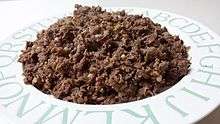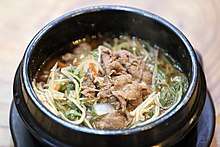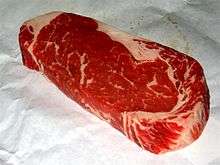Bulgogi
 | |
| Type | Gui |
|---|---|
| Place of origin | Korea |
| Associated national cuisine | Korean cuisine |
| Main ingredients | Beef |
| 150 kcal (628 kJ)[1] | |
| Similar dishes | Neobiani, galbi, yakiniku |
| Korean name | |
| Hangul | 불고기 |
|---|---|
| Revised Romanization | bulgogi |
| McCune–Reischauer | pulgogi |
| IPA | [pul.ɡo.ɡi] |
Bulgogi (/bʊlˈɡoʊɡiː/ buul-GOH-ghee;[2] from Korean bul-gogi [pul.ɡo.ɡi]), literally "fire meat", is a gui (Korean-style grilled or roasted dish) made of thin, marinated slices of beef or pork grilled on a barbecue or on a stove-top griddle. It is also often stir-fried in a pan in home cooking. Sirloin, rib eye or brisket are frequently used cuts of beef for the dish. The dish originated from the north area of the Korean Peninsula and is very popular in South Korea.[3] In fact, bulgogi is widespread in South Korea, such as at fancy restaurants and at local supermarkets selling pan-ready kits.[4]
Etymology
Bulgogi came from the Korean word bul-gogi (불고기), consisting of bul ("fire") and gogi ("meat"). The compound word is derived from the Pyongan dialect, as the dish itself is a delicacy of Pyongan Province (currently in North Korea).[5] After the liberation of the Korean Peninsula from Japanese forced occupation in 1945, the dish became popular in Seoul and other parts of South Korea, by refugees from Pyongan.[6] It was then listed in the 1947 edition of the Dictionary of the Korean Language, as meat grilled directly over a charcoal fire.[7]
In the Standard Korean Language Dictionary published by the National Institute of Korean Language, the word is listed as meat such as beef that is thinly sliced, marinated, and grilled over the fire.[8] The word is also included in English-language dictionaries such as Merriam-Webster Dictionary and Oxford Dictionary of English.[9][2] Merriam-Webster dated the word's appearance in the American English lexicon at 1961.[9]
History
Bulgogi is believed to have originated during the Goguryeo era (37 BCE – 668 CE), when it was originally called maekjeok (맥적), with the beef being grilled on a skewer.[10][11] It was called neobiani (너비아니), meaning "thinly spread" meat,[12] during the Joseon Dynasty and was traditionally prepared especially for the wealthy and the nobility.[13]
Preparation and serving




Bulgogi is made from thin slices of sirloin or other prime cuts of beef.[14] Before cooking, the meat is marinated to enhance its flavour and tenderness with a mixture of soy sauce, sugar, sesame oil, garlic, ground black pepper, and other ingredients such as scallions, ginger, onions or mushrooms, especially white button mushrooms or matsutake. Pureed pears and onions are often used as tenderizers. Sometimes, cellophane noodles are added to the dish, which varies by the region and specific recipe.[11][12]
Bulgogi is traditionally grilled, but pan-cooking has become popular as well. Whole cloves of garlic, sliced onions and chopped green peppers are often grilled or fried with the meat.[12] This dish is sometimes served with a side of lettuce or other leafy vegetable, which is used to wrap a slice of cooked meat, often along with a dab of ssamjang, or other side dishes, and then eaten together.[15]
In popular culture
Bulgogi is served in barbecue restaurants in Korea, and there are bulgogi-flavoured fast-food hamburgers sold at many South Korean fast-food restaurants. The hamburger patty is marinated in bulgogi sauce and served with lettuce, tomato, onion, and sometimes cheese.[16][17]
See also
References
- ↑ "bulgogi" 불고기. Korean Food Foundation (in Korean). Retrieved 8 April 2017.
- 1 2 "bulgogi". Oxford Dictionary of English. Oxford University Press. Retrieved 8 January 2017.
- ↑ Power, John; Ozawa, Miwako (5 June 2015). "Gorging on steak, cheese and two bottles of Cristal champagne in one sitting: Former chef reveals the extravagant tastes of Kim Jong-un that has led to North Korean dictator's massive weight gain". Daily Mail. Retrieved 23 March 2017 – via Mail Online.
- ↑ Kim, Violet (2015-08-13). "Food map: Eat your way around South Korea". CNN. Retrieved 2017-02-27.
- ↑ 이, 기문 (Winter 2006). "'bulgogi' iyagi" ‘불고기’ 이야기 (PDF). The New Korean Language Life. 16 (4): 77–83.
- ↑ Gim, Girim (July 1949). "Saemarui imojeomo" 새말의 이모저모. Hakpung (in Korean). 2 (5): 19–33.
- ↑ Korean Language Society (1947). Joseon mal keun sajeon 조선말큰사전 [Dictionary of the Korean Language] (in Korean). Seoul, Korea: Eulyoo Publishing. p. 1449.
불-고기【이】숯불에 얹어서 직접 구워 가면서 먹는 짐승의 고기.
- ↑ "bulgogi" 불고기. Standard Korean Language Dictionary (in Korean). National Institute of Korean Language. Retrieved 4 May 2017.
- 1 2 "bulgogi". Merriam-Webster Dictionary. Encyclopædia Britannica. Retrieved 4 May 2017.
- ↑ The origin of bulgogi Archived 2010-02-01 at the Wayback Machine., official site of the Ministry of Culture, Sports and Tourism, South Korea.
- 1 2 (in Korean) Bulgogi Archived June 10, 2011, at the Wayback Machine. at Encyclopedia of Korean Culture
- 1 2 3 (in Korean) Bulgogi at Doosan Encyclopedia
- ↑ (in Korean) "Archived copy". Archived from the original on 2011-10-11. Retrieved 2011-05-03.
- ↑ Bulgogi, Korean Spirit and Culture Project
- ↑ (in Korean) Bulgogi Archived July 22, 2011, at the Wayback Machine., Hanwoo Board
- ↑ (in Korean) Bulgogi burger, Asia Today, 2009-09-11. Retrieved 2010-06-27.
- ↑ (in Korean) Upgrade burgers Archived August 11, 2010, at the Wayback Machine., Hankook Ilbo, 2010-06-17.Retrieved 2010-06-27.
External links
| Look up bulgogi in Wiktionary, the free dictionary. |
| Wikimedia Commons has media related to Bulgogi. |
| Wikibooks Cookbook has a recipe/module on |
- "Bulgogi – Korean food storytelling". Korean Food Foundation.
- "Bulgogi – recipe". Chosŏn ryori. Korean Association of Cooks.
- "BEEF-ore You Eat: A Guide To Korean Beef". Korea.net. Korean Culture and Information Service.
